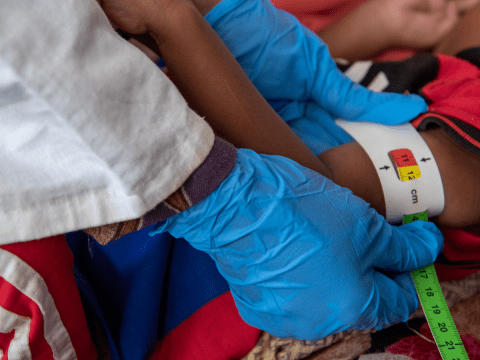Almost 8 million people in Eastern Africa, including vulnerable children, face an acute hunger crisis as the region endures its worst drought in modern history

Millions of hungry children in Eastern Africa will face long-term health consequences or die if they don’t urgently get the food aid they need, warns World Vision International.
A combination of conflict, COVID-19 and the climate crisis has pushed almost 8 million people, including vulnerable children, across seven countries in Eastern Africa into an acute hunger crisis that is only being made worse by wheat shortages and price spikes caused by the conflict in Ukraine.
In the one year since World Vision launched its multi-country hunger response things have gone from bad to worse. Early warning alerts to the looming dangers have not been sufficiently heeded and now close to 28 million people across the region need humanitarian assistance due to varying levels of food insecurity. More than half a million people are living under catastrophic famine-like conditions, marked in the humanitarian sector by critical acute malnutrition, starvation, destitution and death. Some 7.4 million people are just one step away from that. Of critical concern are the 5.5 million children experiencing high levels of malnutrition.
Andrew Morley, World Vision International President and CEO, said: “The impact of drought across this entire region is utterly devastating for children and their families.
“I met one mother, Mary, who checks the pulse of her six-month-old daughter, during the night to make sure she is still alive.
“Livestock are dying, and parents are pulling children out of school because they cannot afford the fees. This means students, like 16-year-old Hannah, who I met in Marsabit, fear they could be forced into child marriage as families’ finances are decimated.
“I met other parents who are giving what food they have to their animals, just to keep them alive.
“Our staff on the ground are bringing hope with water, cash transfers, and food distributions – yet the drought intensifies, and the international response is drastically underfunded.
“We must act urgently to make sure children are not robbed of their futures and can fulfil their God-given potential in life.”
Conflict remains the biggest driver of hunger in the world. Every country in Eastern Africa is either in conflict or a neighbour to one. The region is also experiencing its worst drought in forty years. Increasingly regular droughts and flash floods have undermined families’ ability to cope with the death of crops and livestock. Conflict in the region; the economic impact of COVID-19; locust invasions that destroyed crops, and the continued aftershocks of the Russia-Ukraine conflict on wheat availability and food prices are driving hunger to unprecedented levels. Wheat prices are up to their highest level since 2008. All of these factors acutely impact children’s access to nutritious food and put their lives at risk.
As poverty and vulnerability increase, children are at much greater risk of harm and abuse. Young children who do not get adequate nutrition are at risk of developmental harm. Children who are hungry cannot study effectively and are pulled from school to work. They sometimes face gender-based violence or are abused sexually for cash or food, or are forced into early marriage.
World Vision is calling for an increase in funding for life-saving health, nutrition, water and sanitation and social protection interventions.
“In the face of unprecedented global demands for humanitarian funding, crises in Eastern Africa are receiving limited international attention. Somalia has only received 4% of the $1.5bn it needs. Time is running out and if we do not act millions of children will be harmed and hundreds of thousands could die,” , said Lilian Dodzo, Regional Leader for World Vision in Eastern Africa. “We appeal to national and international donors to step up funding. We know we can save lives and work to address the impacts of climate change.”
World Vision’s Eastern Africa Hunger Emergency Response comprises Ethiopia, Kenya, Somalia, South Sudan, Sudan, Tanzania and Uganda. World Vision aims to reach approximately 7.1 million people, including 3.4 million children and needs an additional US$77 million to extend its response.
The region is not alone in its hunger crisis warning. Globally, more than 45 million people are at risk of starvation or vulnerable to famine or famine-like conditions.
ENDS.
For further information or to organise an interview, please contact:
Jennifer Watson
Regional Communications & Public Engagement Director – Eastern Africa
Email: Jennifer_Watson@wvi.org
Phone: +254 780 55 43 94
World Vision is a global Christian humanitarian, development and advocacy organisation dedicated to working with children, families and their communities to reach their full potential by tackling the root causes of poverty and injustice. World Vision serves all people, regardless of religion, race, ethnicity or gender. For more than 40 years, World Vision has partnered with communities in nine countries across Eastern Africa: Burundi, Ethiopia, Kenya, Rwanda, Somalia, South Sudan, Sudan, Tanzania and Uganda. Our strategy is a promise to build brighter futures for vulnerable children in Eastern Africa. World Vision integrates the global Sustainable Development Goals into its own development and emergency-response programming. For more information, please visit http://www.wvi.org or follow us on Twitter @WorldVisionEARO and @WorldVision
https://www.wfp.org/stories/ukraine-war-more-countries-will-feel-burn-food-and-energy-price-rises-fuel-hunger-warns-wfp
Name changed for privacy reasons
https://news.un.org/en/story/2022/02/1111472
https://news.un.org/en/story/2022/03/1114902